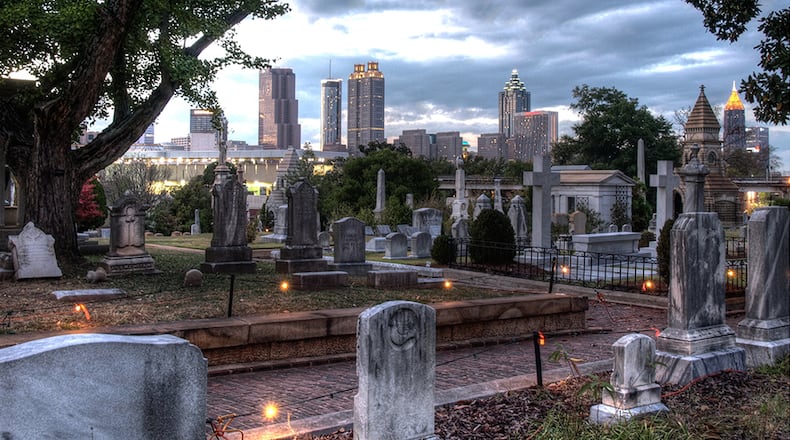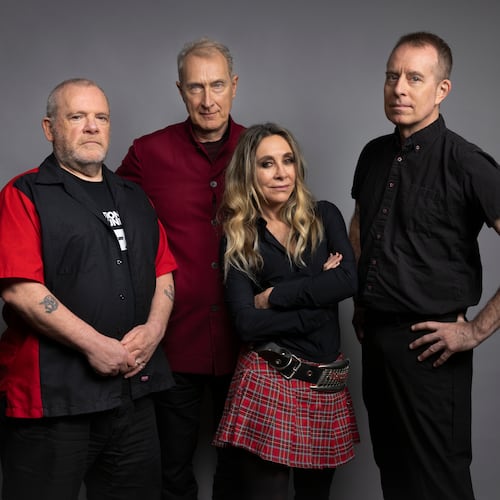Want to be around famous people? Athletes or even notorious criminals? Maybe those who shaped history or were business tycoons? Then visit a cemetery. They are all there. And, in some, the residents may rise up to greet you.
“Cemeteries demand to be interpreted,” says Mary Margaret Fernandez, special event and volunteer manager at the Historic Oakland Foundation. “It serves as a mirror for history. A cemetery is a record of history and is unchanging — the good, the bad and the ugly.”
As Halloween and the Day of the Dead approach, The Atlanta Journal-Constitution offers an overview of our area’s cemeteries and their residents.
Famous and fabulous
Two of the city’s best-known cemeteries feature beautiful grounds, elaborate headstones and are a virtual Atlanta who’s who.
With more than 582 acres, Westview Cemetery, the Southeast’s largest civilian cemetery, is located about four miles west of downtown.
The cemetery dates back to 1884 when 27 Atlantans, including Grant Park’s namesake, L.P. Grant, W.P. Inman and Jacob Elsas, purchased 577 acres. The original cemetery had a section for blacks, called Rest Haven, a pauper’s grave, God’s Acre, with 5,000 people buried, and a section for the Irish, Masons and Salvation Army members.
Coca-Cola heir Asa Candler Jr. bought it in 1943 and started construction on Westview Abbey, an ornate building with intricate stonework and 27 stained glass panels that depict the life of Christ. The Receiving Tomb was built in 1888 to hold bodies waiting to be processed and buried and also housed the overload of bodies during the 1918 flu outbreak.
Among the famous buried here are Coca-Cola founder Asa Candler, Joel Chandler Harris, Joseph and Evelyn G. Lowery, Ralph McGill, Robert Woodruff and Frank Gordy, founder of the Varsity.
Historic Oakland Cemetery is Atlanta’s oldest public park and the final resting place for Bobby Jones, Ivan Allen Jr., Maynard Jackson and Margaret Mitchell.
Located off Memorial Drive, it was purchased by the city in 1850 and by 1872 had expanded from six to 48 acres. The last burial sites were sold in 1884. “We have no plots available, but we do have situations where families die out, and there are empty plots. We have a waiting list,” says Fernandez. “We probably have 12 funerals a year. We have more weddings.”
As typical of its time, Oakland was segregated. There is a section where slaves were buried (“Slave Square”), as well as public grounds where paupers were buried, oftentimes in unmarked graves. Oakland has three Jewish burial sites, including one for Russian immigrants and German Jews. It is also the burial site for more than 7,000 Confederate soldiers, again, many unknown.
Credit: Joey Ivansco / jivansco@ajc.com
Credit: Joey Ivansco / jivansco@ajc.com
Today, people enjoy the gardens and partake in activities sponsored by the foundation. “You’ll never hear us talk about hauntings or the afterlife beyond the beliefs of the individual resident,” says Fernandez. “We mean to enlighten, not frighten.”
Throughout the year (pre-pandemic), the foundation hosted a variety of events including a pumpkin carving workshop, a Run like Hell 5K and Malts and Vaults: Where Beer Meets History.
This year, one of its most popular events, the Capturing the Spirit of Oakland, will be a virtual film experience where performers will “bring to life” a few of the cemetery’s residents, including a prison matron, a Shakespearean actor and a prominent seamstress.
Haunted
Historic Lawrenceville Cemetery has long been the center of haunted rumors, and attempts to document the popular hearsay haven’t exactly disproven the theories. The Aurora Theatre conducts ghost tours in September and October.
“We tell stories about the people who are buried there and talk about strange unexplained things. We give people the opportunity to walk around and see if they experience anything,” says Timothy Whitson, the director and manager of the Lawrenceville Ghost Tours. Some people just want to have a good time; others appreciate the history, and finally, there are ghost hunters, he says. “I’ve had several folks take pictures of something they see, and some have frequently heard a little girl giggling.”
The cemetery, located on East Pike Street and Highway 20, near the downtown square, is the final resting place of Gwinnett County founders William Maltbie and Elisha Winn and Lawrenceville’s first mayor, John Clay Smith. There are unmarked graves of former slaves, two African-Americans with inscribed grave markers but no birth or death dates, eight Confederate soldiers and Revolutionary War veteran Nathan Spence. It is also the burial sites of Col. James Austin, a local slave owner, and his slave, Elleck, who fought with Austin and was hung.
Black heroes
Founded in 1886 by former slaves, South-View Cemetery, 15 minutes south of downtown, is the city’s oldest African-American cemetery. It consists of 100 acres of green space with 80,000 people buried there.
Buried here are the parents of MLK — Daddy and Mrs. King — Julian Bond, Jesse Hill, Herman J. Russell, John Lewis, John Wesley Dobbs and two members of Gladys Knight’s Pips. In addition, seven Missing and Murdered victims are buried here, as well as the rapper Bankroll Fresh, players for the Atlanta Crackers and 22 who have or had schools named for them.
Credit: JOHNNY CRAWFORD / AJC
Credit: JOHNNY CRAWFORD / AJC
Holocaust memorial
Located on Cascade Circle, Greenwood Cemetery was chartered in 1904 and has a large Jewish section as well as being a burial place for Chinese and Greek citizens. Perhaps most touching is the Holocaust memorial, the “Memorial to the Six Million,” a small granite structure with the names of people who died in concentration camps inscribed on the walls. There is also an urn containing ashes brought from the Dachau concentration camp.
The Greek section was established in 1911 while the Chinese lot is enclosed on three sides with an iron-pipe rail fence with an obelisk in the center.
S. Truett Cathy — the founder of Chick-fil-A — is buried here, too.
Sandy Springs notables
Arlington Memorial Park, located on Mount Vernon Highway, covers 122 acres of rolling hills with mature trees and two lakes. The first burial took place in 1922.
Among the notables buried there are Harry “Skip” Caray Jr., Roberto Goizueta, NHL player Tom Lysiak, Lester Maddox and Millicent Jane Schneider, who was unofficially known as the "Telephone Lady. " She voiced the messages on the phone telling you the number dialed was wrong or was no longer in service.
Slave and African American cemeteries
Drive off I-75 on Cleveland Avenue and you’ll find a cemetery built in 1842 by plantation owner Jeremiah Gilbert for his slaves and their families. It was also used after the Civil War for Plunkett Town burials, an African American community. About 1,700 people were buried here, and there is an obelisk with the names of persons whose names were found on stones.
An erratic tennis ball or fly ball from Frankie Allen Park might land in Mt. Olive Cemetery, where there are anywhere from 45 to more than 100 marked and unmarked graves. The cemetery is what’s left of Macedonia Park, a settlement by freed slaves and one of the city’s first Black communities.
Located on Canterbury Road in Buckhead, the Piney Grove Cemetery was part of an African-American community that dates back to the mid-1820s. The cemetery has fought off development efforts and has remained intact with the graves of more than 300 people, including slaves.
Military
The Marietta National Cemetery was established in 1866 for the nearly 10,000 dead Union soldiers from Sherman’s Atlanta Campaign. Currently, there are 18,742 internments. Broadway star Matthew Broderick — while searching his family history in “Who Do you Think you Are?” — discovered his great-great-grandfather was buried in what was the last unmarked Union grave. Adjacent to the Marietta National Cemetery is the Marietta Confederate Cemetery, which has more than 3,000 graves from Confederate soldiers.
WHERE TO GO
Westview Cemetery. 9 a.m.-5 p.m. Monday-Friday; 9:30 a.m.-2 p.m. Saturday. 1680 Westview Dr. SW, Atlanta. 404-755-6611, westviewcemetery.com.
Historic Oakland Cemetery. 9 a.m. - 5:30 p.m. Sunday-Saturday. 248 Oakland Ave. SE, Atlanta.. 404-688-2107, oaklandcemetery.com.
South-View Cemetery Association. 9 a.m. - 5 p.m., Monday- Sunday. 1990 Jonesboro Road, SE, Atlanta. 404-622-5393, southviewcemetery.com.
Arlington Memorial Park. Open 24 hours every day. 201 Mount VernonHighway, Sandy Springs. 404.255-0750, dignitymemorial.com.
Marietta National Cemetery. 8 a.m.- 4:30 p.m. Monday-Friday; closed Saturday, Sunday. 500 Washington Ave. NE, Marietta. 866-236-8159, cem.va.gov/cems/nchp/marietta.asp.
About the Author
The Latest
Featured






